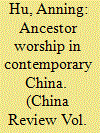|
|
|
Sort Order |
|
|
|
Items / Page
|
|
|
|
|
|
|
| Srl | Item |
| 1 |
ID:
144096


|
|
|
|
|
| Summary/Abstract |
Although ancestor worship has been widely acknowledged as one of the most significant cultural traditions in Chinese society, information about its nationwide popularity and followers’ sociodemographic characteristics is still not clear. Taking advantage of the first nationwide survey on Chinese residents’ spiritual life, this study examines: (1) the extent of popularity of typical ancestor worship practices, (2) the sociodemographic features of ancestor worship individuals, and (3) the “magical” elements of ancestor worship activities. Empirical results suggest that, first, the most popular ancestor worship practices in contemporary China are venerating the spirits of ancestors or deceased relatives and visiting the gravesite of ancestors. Ancestor worship practice participants make up over 70 percent of the adult population. Second, on average, males are more active in ancestor worship than females. Also, economic status is positively associated with ancestor worship participation. Nevertheless, urbanization and migration have a negative effect on people’s propensity of practicing ancestor worship. Third, the magical aspect of ancestor worship is less attractive to well-educated adults, but more likely to be followed by senior individuals.
|
|
|
|
|
|
|
|
|
|
|
|
|
|
|
|
| 2 |
ID:
185502


|
|
|
|
|
| Summary/Abstract |
This article focuses on the Flat Land Yao (Pingdi Yao,平地瑶) people’s ancestor worship reflected in the Meishan scroll paintings which were discovered in Shuibin village, Guanyin township, Gongcheng Yao Autonomous District, Guangxi Zhuang Autonomous Region, China in 1984. The Yao people believed that Meishan was not only their ancestral habitation located in ancient central Hunan, but also the pure land for the ancestors’ souls. For the long migration duration and the unfavourable preservation environment, the existing number of Meishan scroll paintings of Flat Land Yao is small, and the two sets of scrolls in Gongcheng Yao Autonomous District are rare art works in the series. The dress style, decoration, generation names of the ancestors, and the skills of the painters reflected that the Flat Land Yao people had absorbed the culture of the surrounding nationalities, especially the Han culture. Confucianism also had an important influence on the Flat Land Yao.
|
|
|
|
|
|
|
|
|
|
|
|
|
|
|
|
| 3 |
ID:
126165


|
|
|
|
|
| Publication |
2013.
|
| Summary/Abstract |
This paper presents a women-centred study of the religious identities and practices of the diasporic Coorgs of Singapore through interviews and observances of their 'religious' practices, focusing on how these first-generation immigrants have created adaptive techniques of ancestor worship and the worship of Kaveriamma to perform their Coorg identity away from their ancestral homeland. Their spiritual practices in the home are contrasted with their engagements in broader Singaporean Hindu society, where issues of cultural identity and religious practice serve as a lens to comprehend how contemporary diasporic 'religiosities' among Coorg women (Kodavathees) are negotiated. The diasporic Kodavathees have found innovative ways to maintain their 'religious' practices and assert their distinct ethnic identity in Singapore, where being Hindu is often narrowly defined by broad social acceptance of the official ethnic taxonomies of the state.
|
|
|
|
|
|
|
|
|
|
|
|
|
|
|
|
|
|
|
|
|